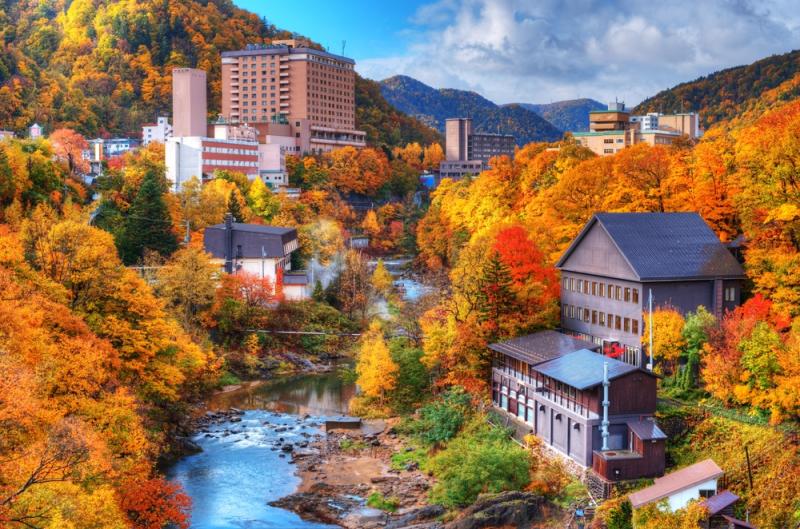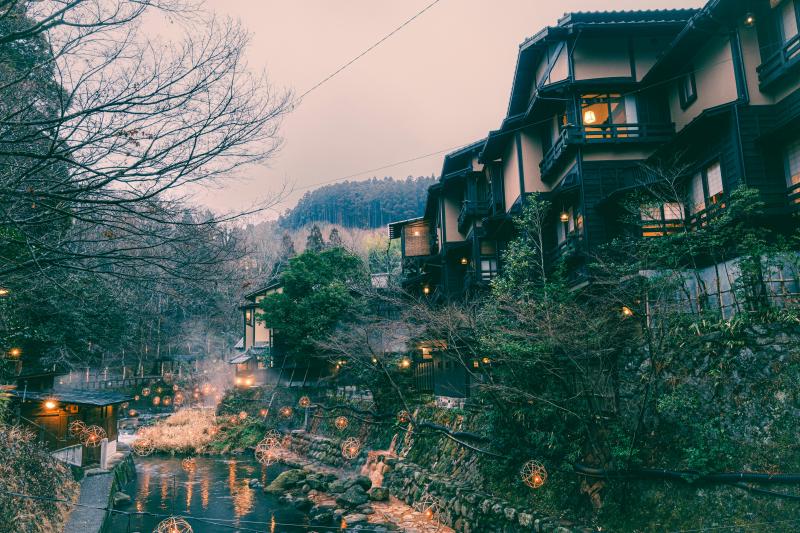Japan Onsen: The Ultimate Guide to Japanese Hot Springs
Last Updated: October 23,2024What is Onsen in Japan? Japan Onsen is the traditional Japanese hot springs, where natural mineral-rich water emerges from the earth's surface. These Japan hot springs have been cherished for centuries for their therapeutic properties, which are believed to alleviate ailments and promote relaxation. How many hot springs are in Japan? Japan has a huge number of more than 3,000 hot springs, with the springs sources number of nearly 30,000, distributed among Hokkaido Hot Springs, Tohoku Onsen, Kanto Hot Springs, Chubu Hot Springs, Kansai Onsen, Chugoku Onsen, Shikoku Onsen, and Kyushu Onsen. Here is the complete guide to the Japan Onsen hot springs, including the best place for hot springs in Japan, secret private Onsen Japan to avoid crowds, hot springs that allow tattoos in Japan, monkey hotspring Japan, recommended Japan hot spring trip, best onsen Ryokan in Japan, Japanese hot springs culture and etiquette, etc. Leave us a message for a tailored private Japan tour if you are interested in a Japanese hot spring experience.
Table of Contents
1. 16 Best Japan Onsen Destinations
2. 13 Hidden Hot Springs in Japan
3. 3 Onsens in Japan That Allow Tattoos
4. 2 Monkey Hot Springs in Japan
5. Recommended Japan Onsen Trip
1. 16 Best Hot Springs in Japan
Japanese Onsen has various health benefits, including improving blood circulation, relieving muscle tension, and even alleviating certain skin conditions. The mineral-rich waters are said to have therapeutic properties. But where is the best place for onsen in Japan? Here are the 16 best onsens in Japan worthy of your visit.
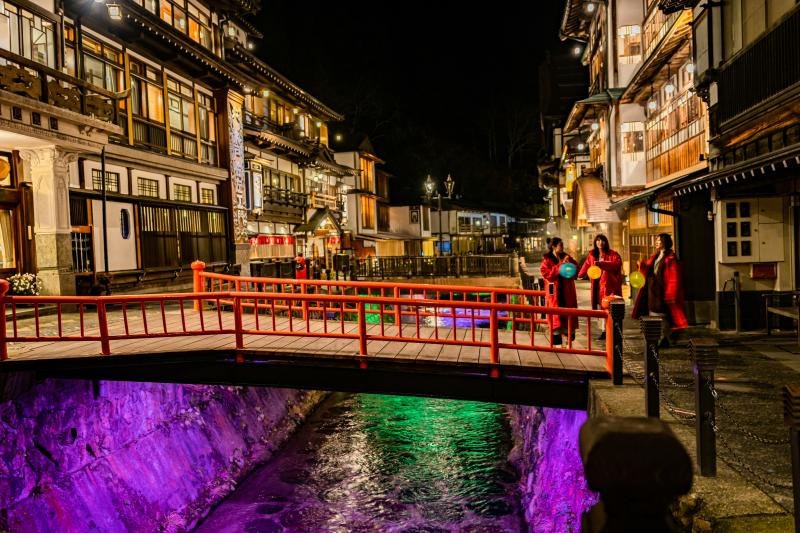
1) Ginzan Onsen Yamagata: A Representative of Yamagata Onsen
Japan Ginzan Onsen has a long history. The spring water was discovered 1500 years ago, and the area was famous for its silver mining, which led to the development of the surrounding area. After the decline of the silver mines, the population lost rapidly, but the discovery of the source of the hot springs once again started a second spring of development. The wooden hot spring houses of the Taisho period, with the white snow on the eaves, the dim lights, and the mist, are our most typical perceptions of hot spring streets in Japanese dramas or movies. The most widely known of the Oka drama "Shin", was set here, and you can enjoy Spirited Away Onsen Japan. But if you visit Ginzan Onsen in Yamagata by car, you have to pay attention to the location of the parking lot first.
Address: Ginzan Shinbazunai, Obanazawa City, Yamagata Prefecture
2) Arima Onsen Hyogo: One of the Best Onsen Resorts in Japan
Located in Hyogo Prefecture, Arima Onsen Kobe is one of the "Top Three Hot Springs in Japan" and the "Three Ancient Hot Springs in Japan" and is the most famous Kobe Onsen. During the Warring States period, Toyotomi Hideyoshi was a great fan of Arima Onsen and visited the hot springs many times, leaving a trail of footsteps.
There are five source baths and two public baths in Arima Onsen, where you can find 11 of the 13 types of hot springs in Japan. The public baths include Kinyu, a reddish-brown hot spring called Kanazumi, and Ginyu, a colorless, transparent carbonate spring, which are Onsen origins (hot springs) that have been handed down from ancient times to the present day.
Access: Kobe to Arima Onsen: Just take the Kobe Electric Railway and get off at Arima Onsen Station.
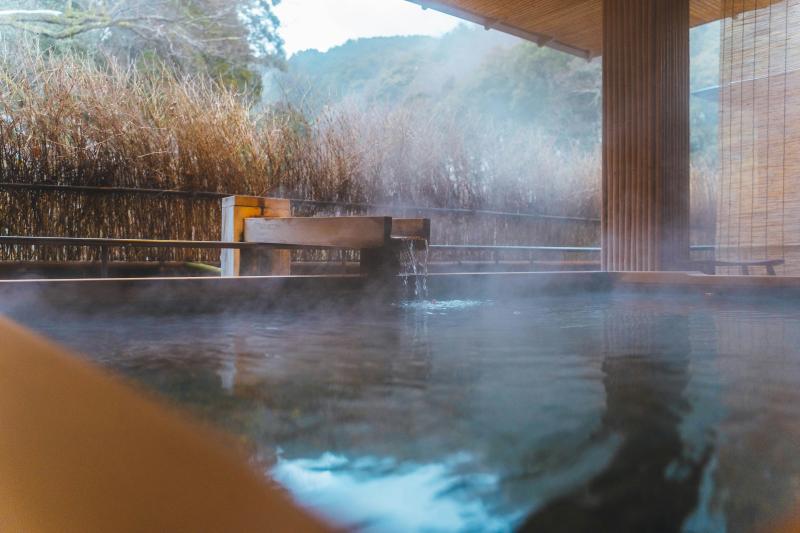
3) Kinosaki Onsen Japan: A Traditional Japanese Hot Spring Town
If there are too many tourists visiting Arima Onsen, then you can go to Japan Kinosaki, which is a little further away, located in Toyooka City, Hyogo Prefecture. Kinosaki Onsen Toyooka is the birthplace of Japanese hot spring tours and is famous for its "Seven Great Hot Spring Tours". If you stay at any local hot spring Ryokan, you can enjoy the seven outdoor baths for free, which is a rare and precious experience for any Japan Onsen trip.
There is Genbudo Park near Kinosaki Onsen Hyogo, where you can see huge rock caves formed by volcanic activity 1.6 million years ago. You can take the cable car to the top of the mountain to overlook the panoramic view of Kinosaki Hot Spring and the majestic mountains in the distance.
Access: Tokyo to Kinosaki Onsen: take the limited express Kinozaki from Kyoto Station, and you can get off at JR Josaki Onsen Station.
Kinosaki onsen from Osaka: take the limited express Kotoori from Osaka Station, and you can get off at JR Josaki Onsen Station.
Kobe to Kinosaki onsen: take the limited express Hamakazu from Kobe Sannomiya Station, and you can get off at JR Josaki Onsen Station.

4) Kusatsu Onsen Gunma: One of the Three Most Famous Hot Springs in Japan
Kusatsu Onsen is so famous that no one in Japan is unaware of it. It is a hot spring town that boasts the highest amount of hot springs in Japan. Yubatake in the middle of the Kusatsu onsen town has become a symbol of the area and a famous tourist attraction, and there are many Kusatsu Onsen Ryokan, where you can experience the traditional culture of "yumomi". The center of Yubatake is densely populated with stores, and in addition to the Gunma Kusatsu Onsen, the area combines all the elements of sightseeing such as meals, restaurants, and souvenirs. Don't miss this place if you want to experience the essence of Japan Onsen.
Access: Kusatsu Onsen from Tokyo, you can take the high-speed bus "JR Bus Kanto Kaminushu Meiyu Yumaguri" directly to "Kusatsu Onsen Bus Terminal".
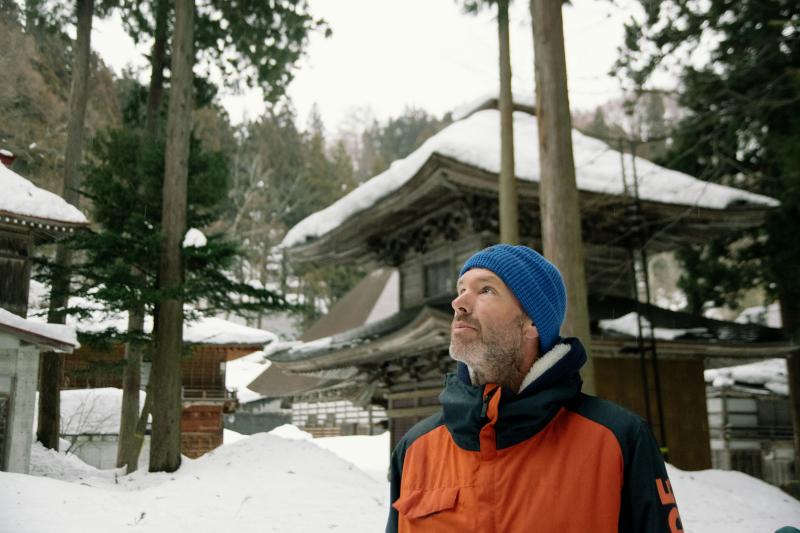
5) Nozawa Onsen Nagano: One of the Best Onsen Villages in Japan and a Ski Town in Northern Nagano Prefecture
As a hot Japan Onsen village, the first thing to do in Nozawa Onsen Japan is of course to take a bath in the hot springs. The 13 natural hot springs in Nozawa Onsen Village are maintained and cleaned by nearby communities and are open to the public free of charge. You need to bring your own towels and toiletries. The location of each hot spring in Nozawa Onsen town can be seen on the map. The ones with more distinctive environments are Onyu, Makiyu, and Nakao-no-yu. However, for short-term travelers, the baths closer to the Nozawa Onsen Ryokan where you live are fine, and they are all very nice and clean.
The flocculent float in the Nozawa hot spring is the crystallization of minerals, which is called "soup flowers" by the Japanese, not garbage, on the contrary, the more floating floats, the better the quality of the spring.
Access: You can get to Nozawa Onsen from Tokyo or Nagano, check how to get to Nozawa Onsen for more details on how to get from Tokyo to Nozawa Onsen and how to get to Nozawa Onsen from Nagano.
6) Dogo Onsen Matsuyama: One of the Three Oldest Hot Springs in Japan
Dogo Onsen Shikoku, located in Ehime Prefecture, is one of the three oldest hot springs in Japan (including Shirahama Onsen in Kagayama Prefecture and Arima Onsen in Gunma Prefecture), and is well known for having been featured in Natsume Soseki's novels, and in modern times as the setting for Ghibli's animation "The Hidden Maiden". The area around Dogo Onsen Ehime is very lively, with sightseeing spots such as Dogo Shopping Street and Togo Station. After enjoying the Dogo Onsen Shikoku, you can take a romantic stroll through the old streets.
Address of Dogo Hot Spring: 6-8, Dogo Yunomachi, Matsuyama-shi, Ehime
7) Noboribetsu Onsen Hokkaido: Natural Sulfur Hot Spring Born from Mount Hiyori
When you visit Mount Hiyori and Noboribetsu Onsen in winter, you can take advantage of the scenery to see the continuous white snow on the mountaintops, accompanied by the white smoke erupting from the active volcano, as if the earth is breathing. This magnificent natural scenery is unique to Hokkaido. Don't miss the natural Noboribetsu spring water that does not freeze at low temperatures and gurgles through the valley. And highly recommend you pay a visit to the famous Jigokudani Hell Valley, which is about a 12-minute walk from Noboribetsu Onsen.
By the way, I would like to mention Oyunuma, which is a natural and free foot bath with grayish spring water that is characteristic of the area. In the freezing cold weather in Hokkaido Noboribetsu, you can sit down and relax in the foot bath, and with the pristine woods in front of you, all your tiredness will be swept away, but don't forget to bring your own towel.
Access: Take the Michinami Bus from the bus terminal in front of Sapporo Station and get off at Noboribetsu Onsen. Or check Noboribetsu Onsen Transportation Guide for more details about Noboribetsu Onsen Bus and Sapporo to Noboribetsu Onsen.
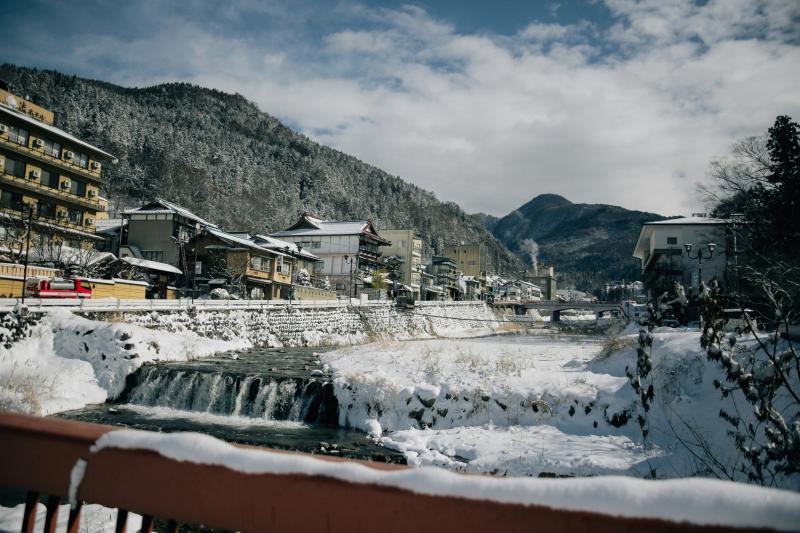
8) Shibu Onsen Japan: Experience the Shibu Onsen 9 Baths for Free
Located in Nagano, Japan, Shibu Onsen is a famous hot spring tourist attraction with a long history in Japan. The natural environment is very beautiful, surrounded by mountains and water, and there are many hot spring resources. As soon as you get off the train there, you will see the vintage-looking Yudanaka Station, which was completed in 1955, and the shape of the building gives you a meaningful feeling of anticipation for the rest of the trip. Come out of the quaint station, there is Onsen Street of Shibu Onsen Nagano, where you will find a lot of tourists and you can clearly feel the atmosphere of the people living in the area. Don't forget to experience the Shibu Onsen 9 Baths which is free of charge if you stay overnight at a shibu onsen ryokan.
Access: Transferring to the Nagano Line of the Nagano Dentetsu, a local line, at Nagano Station on the Shinkansen Line, you will arrive at the final destination, Yudanaka Station, in about 50 minutes while enjoying the idyllic scenery known as Kitashinano.
Warm Tip: Check How to Get to Shibu Onsen if you want to know about more transportation guides to Shibu Onsen from Tokyo, Shibu Onsen From Kyoto/Osaka, and Local Transportation in Shibu Onsen.
9) Hakone Onsen: A Popular Hot Spring Resort in the Kanto Region
Hakone is a popular hot spring destination in the Kanto region due to its convenient public transportation and proximity to Tokyo.
Hakone Japan Onsen has a wide variety, ranging from hot springs with a view of Mt. Fuji, to onsen Ryokan with individual private baths, to entertaining hot spring parks, to hot spring inns close to bustling shopping districts, and to one-day hot spring resorts that offer Onsen bathing services only.
Hakone Onsen Kanagawa is known as the "Hakone Seventeen Hot Springs", which refers to the hot springs located in 17 districts in Hakone, and the quality of the springs and their effects vary from district to district. For example, Tanosawa Onsen, Miyanoshita Onsen, Dogashima Onsen, and Sokokura Onsen in the northeast part of Hakone have "sodium-chloride spring water" that is effective in relieving neuralgia and skin problems. Sengokuhara Onsen has calcium-sulfate spring water, which is known as "the spring of beautiful skin". There are also Hakone Yumoto Onsen and Kowakudani Onsen, both of which are "alkaline springs," and are known for their ability to relieve neuralgia and chills. Don't miss the Hakone Yuryo Onsen and Hakone Kowakien Yunessun Japan if you want to experience more Hakone Japan hot springs.
Access: From Shinjuku Station, you can get to Hakone-Yumoto Station in as little as 73 minutes on the Odakyu Dentetsu "Romance Express" train. Alternatively, you can take a bus to Hakone Momoyendai Station in about 125 minutes.
Warm Tip: Check the Ultimate Transportation Guide to Onsen Hakone for more details on departing from Tokyo Station, from Shinjuku Station, from Kyoto Station, or from Osaka Station to Hakone Onsen Town.
10) Kyoto Onsen: More than 30 Hot Spring Villages Await You
For the best Onsen in Kyoto, you can choose Arashiyama Hanaikada Kyoto and Fufu no yu Kyoto, or Ogoto Onsen. Ogoto Hot Spring is more recommended because of its cost-effectiveness. Most of the bath services are provided by hot spring hotels, so even if you don't want to stay overnight, it's possible to choose just the bath. If your Kyoto hot springs itinerary is to stay in Kyoto for 1 night, but you want to experience the fun of a Japanese-style Kyoto Onsen Ryokan, Ogoto Onsen will be the best choice.
Although there are 3 other hot spring spots in Kyoto, including Kyoto Arashiyama Onsen, which are a bit expensive and inconvenient to get to. Ogoto Onsen Street is the closest hot spring village to Kyoto, and it's only a 20-minute drive from Kyoto Station. With a history of 1,200 years, Ogoto hot spring is located on the western side of Lake Biwa at the foot of the World Heritage Site Mount Hiei, and the view as the sun sets is breathtaking. The quality of the Ogoto Onsen is comparable to that of Japan's famous Gero Onsen, which is a great way to relax, relieve fatigue, and help improve your body in the fall and winter, as well as beautify your skin. There are only eight hot spring hotels in Ogoto, ranging from open-air baths facing Lake Biwa to cozy family-run inns run by kindly old couples.
For the Onsen Kyoto Japan beyond Kyoto city, Kurama Onsen Kyoto is very clean and not too crowded, so it's great for enjoyment, and the key is that it's also very inexpensive, and you can soak in the hot springs while enjoying the beauty of nature. Check the Top 3 Hot Springs near Kyoto for more related readings.
11) Tokyo Onsen: Enjoy the Japanese Hot Springs in the City
Hot springs are one of the symbols of Japan, and everyone wants to experience an authentic Japanese onsen when traveling to Japan. However, most Japanese hot springs are located far away from the city, in the mountains and forests, so it is not convenient to go there unless you have time to spare. In fact, there are also some hot springs in the city worth visiting. Tokyo, the capital of Japan with a population of more than 13 million, has excellent hot springs both in the city and on the outskirts of the city for you to enjoy Japanese hot spring, like LaQua, Somei Onsen Sakura, Toshimaen Niwa No Yu, Times Spa Resta, Thermae Yu, etc.
Odaiba Oedo Onsen Monogatari is very famous among Tokyo onsen, however, it was permanently closed, just please be cautious about it.
Tokyo odaiba oedo onsen monogatari is the Natural hot springs in Tokyo. It is about a 4-minute walk from the Telecom Center Station on the Yurikamome Line. The water of Odaiba Tokyo Oedo Onsen Monogatari is a natural hot spring that springs from 1,400 meters below the ground, and the quality of the spring is weakly alkaline with a hint of tawny color, which is effective in treating muscle aches and pains, sore shoulders, cold hands and feet, burns, etc.
Warm Tip: There are also some famous Onsens in Japan that are not so far from Tokyo, like Kusatsu Onsen, Hakone Onsen, Nozawa Onsen, Shibu Onsen, Takaragawa Onsen, etc. You can check the Transportation Guide to Onsen Town near Tokyo for more details.
12) Osaka Onsen: Visiting the Largest Hot Spring Theme Park in Kansai
As a hot spring area in Japan, Osaka in the Kansai region has numerous hot spring resources, and these hot springs are not only numerous in number, but also have their own characteristics, making people unforgettable when dipping in the Onsen Osaka. Therefore, if you are traveling to Osaka and hope to experience the Osaka hot spring, the Solaniwa Onsen Osaka Bay Tower is a very good choice. It is a theme park located in the center of Osaka City, and the entire spa is decorated in the distinctive style of the Japanese Azuchi Momoyama period. It offers a wide range of services, including onsen, entertainment, relaxation, and food and drink. After entering the Solaniwa Onsen Osaka Bay Tower, you can choose your favorite yukata (bathrobe) and then move around freely in the private onsen Osaka. In addition, World Spa Osaka is also a great Japan Onsen spa worthy of your visit if you hope to experience more onsen in Osaka.
13) Fuji Kawaguchiko Onsen: The Japan Hot Spring Town Closest to Mount Fuji
Kawaguchiko Onsen, with its close view of Mt. Fuji and convenient public transportation from Tokyo to Kawaguchiko, attracts many tourists. For the characteristics of the Kawaguchiko hot springs, the Onsen Fujikawaguchiko is composed of "Reiho Onsen", "Tensui Onsen", "Reimizu Onsen", "Furusu Onsen" and "Hidari Onsen" with abundant springs.
The water of Kawaguchiko Onsen is salted with calcium and carbonic acid, and is good for neuralgia, muscle pain, coldness, and fatigue.
After enjoying the Mt Fuji Lake Kawaguchiko Onsen, you can pay visits to the Sengen Shrine, Kawaguchiko Museum of Art, Yamanashi Gem Museum, Kawaguchiko Music Box No Mori Museum of Art, etc. and there are many Mt Fuji onsen hotels with great views of Mt. Fuji for you to stay overnight, such as Fujikawaguchiko Onsen Konanso, Fuji Kawaguchiko Onsen Hotel New Century, Fujisan onsen hotel Kaneyamaen and Shuhoukaku Kogetsu.
Access: You can take the "Fuji Circle" train in Shinjuku, which takes about 2 hours directly, or transfer to the "Fuji Kyuko Line" at "Otsuki" Station. You can also take direct buses at the bus stations in Tokyo, Shinagawa, and Shinjuku.
Warm Tip: Check Tokyo to Lake Kawaguchiko Transportation for more details on Tokyo to Kawaguchiko station via various transportation options, like by High-speed Bus, Private Car, Fuji Excursion JR-East, or Train + Bus.
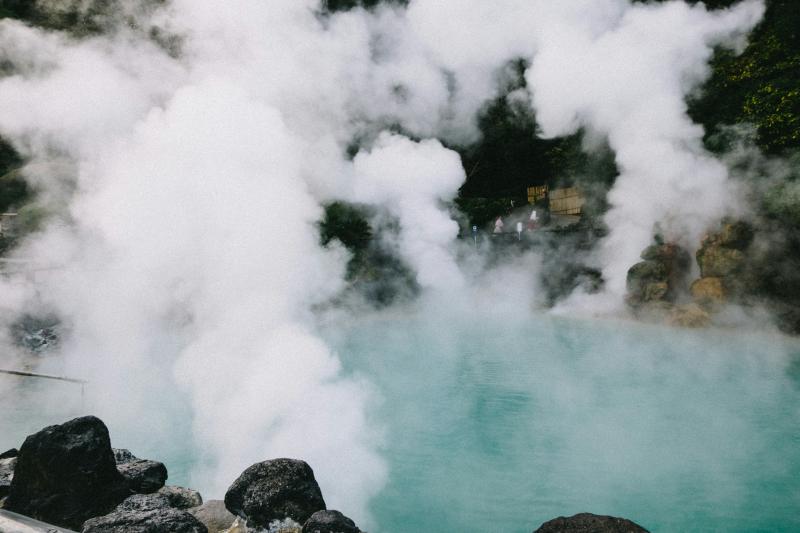
14) Beppu Onsen: A Renowned Hot Spring Resort Town in Oita, Prefecture
Beppu Onsen Japan is located in Beppu City, Oita Prefecture, northeastern Kyushu, Japan. Since the Nara Period, this area has been a famous "hot spring town" in Japan, with a wide variety of hot springs. The amount of hot springs is the second largest in the world, second only to Yellowstone National Park in the United States. The most famous Oita Beppu Onsen are the 7 hells hot springs (Umi Hell, Blood Pond Hell, Tornado Hell, White Pond Hell, Onishibozhu Hell, Kitchen Hell, and Onishan Hell), which attracts many tourists coming here to experience a Beppu Hell Tour.
Beppu Otia Onsen Address:559-1, Tekawa, Beppu-shi, Oita-ken
Warm Tip: Check the Transportation Guide to Beppu Onsen, which includes How to Get to Hells of Beppu and Beppu to Yufuin.
15) Gero Onsen: One of the Three most Famous Hot Springs in Japan
Gero Onsen Town is very well known and has a high popularity value. Gero Hot Springs is located in Gifu Prefecture in the central part of the country. If you go to Shirakawa-go or Takayama, you should stop by. Gero Onsen Japan has a history of more than a thousand years. It produces alkaline simple springs, which are helpful for rheumatic diseases and relieve fatigue.
Gero Onsen has a famous hot spring street here, which is located in the hinterland between the green mountains and green waters on both sides of Mount Hida. Almost all hot spring hotels are built on the mountains, making them very secluded. Therefore, local hotels usually have buses to and from JR stations.
Access: Take JR from Nagoya Station to Gero Station.
16) Yufuin Onsen: Kyushu's Leading Hot Spring Resort and Famous Summer Resort
Compared to the Japan hot springs introduced above, Yufuin hot spring has a medium popularity value. In addition to Beppu Hell Onsen, there is also Yufuin Onsen in Oita Prefecture. It is one of the leading hot spring resorts in Kyushu and a famous summer vacation spot, with the third largest amount of springs in Japan. The idyllic scenery complements Yufuin Onsen Oita and makes it look particularly gentle.
Access: By highway bus directly from Fukuoka Hakata Bus Stop.
3. 3 Onsen in Japan with Tattoos
Is there any Japan Onsen that allow tattoos? Most of the Japanese Onsen may have rules on tattoos, and you may need to ask for the permission to Onsen. Fortunately, there are a few hot springs in Japan that allow tattoos, including the following 3 tattoo-friendly Onsen in Japan.
1) Fureai Onsen Yata: Public Bath in Osaka with Natural Hot Spring
Fureai Onsen Yata stands as a serene haven, a public bath where the local community converges in an atmosphere of relaxation, uniquely inclusive of individuals adorned with tattoos. Despite its public nature, the defining feature lies in its natural hot spring source, triumphantly unearthed for the first time in Osaka city in 1988. Offering a spectrum of bathing experiences, including open-air, electric, cold, and jet baths, the facility extends its appeal with a complimentary outdoor footbath. In essence, Fureai Onsen Yata seamlessly blends indoor and outdoor tubs, both enriched with the restorative essence of natural spring water. Modern amenities and an affable attitude towards tattoos characterize this onsen, complemented by dining options to enhance the overall experience.
2) Healthy Spa Tateba: Public Bath in Osaka with Great Experience of Japanese Culture
Situated conveniently in Osaka City, Healthy Spa Tateba is a tattoo-friendly onsen that stands out for its accessibility. It's an ideal choice for those exploring Osaka, offering various baths, including a cold plunge bath, and amenities such as a steam room—all covered in the standard entry fee, saving extra costs for the sauna.
Known for its popularity among locals, Healthy Spa Tateba provides an authentic onsen experience. The availability of an English support leaflet caters to international visitors, while rental towels and amenities add to the overall convenience.
For foreign visitors, Healthy Spa Tateba offers seamless English support and affordable, delicious food options after enjoying the baths. It provides a glimpse into Japanese culture, ensuring a secure and enjoyable experience, especially for solo female travelers. With a focus on catering to the needs of foreigners, Healthy Spa Tateba promises a well-rounded and culturally enriching visit.
Also check onsen in Osaka that allow tattoos for more tattoo onsens options in Osaka.
3) Hōheikyō Hot Spring: A Great Outdoor Hot Spring in the Snow
Hōheikyō Hot Spring in Sapporo, Hokkaido, is a tattoo-friendly onsen with a beautiful mountain view, especially enchanting in winter with a snowy landscape. The mix of cold weather, mountain breezes, and warm water offers a unique and memorable experience. The outdoor pool maintains a pleasant temperature of 39 to 41 degrees Celsius, adding to the charm. Indoors, there's another inviting pool with convenient shower stations. Visitors use lockers and can rent towels on-site or bring their own. After a soak, a cozy sitting area with heated flooring awaits, and a vending machine provides beverage options.
Hōheikyō Hot Spring is not just a soak but an essential part of any Sapporo trip. The natural beauty of its outdoor pools is unparalleled, offering tranquility and stunning views.
While a bit far from central Sapporo, it's easily accessible by bus, particularly the Kappa liner from the Sapporo bus terminal. However, be mindful of the bus schedule, especially for the return trip, as the last bus departs in the early evening.
If you look for Onsens in Tokyo that allow tattoos, we will try our best to find more Japan hot springs tattoos.
4. 2 Monkey Hot Springs in Japan
Where are the hot spring monkeys in Japan for visitors to see monkeys bathing in the Onsen? Have you ever imagined soaking with Japanese snow monkeys in Japan monkey hot springs? Let's make it realized for you.
1) Jigokudani Hot Spring: An Outdoor Monkey Onsen Can Look Straight to the Snow Monkey Park
Nagano Jigokudani Onsen is one of the famous hot springs located in the Yudanaka Onsen area and is known for the monkeys that bathe in the hot springs in winter. This is the only natural attraction in the world where you can see wild monkeys soaking in the hot springs.
The Japanese monkeys initially only bathed in hot springs out of imitation, but after experiencing the comfort of soaking in hot springs when the weather was freezing, they gradually developed the activity of bathing in hot springs into a habit. Currently, there are about 160 monkeys living around the Japan monkey hot springs. On snowy days, the monkeys go into the bath together in the Nagano monkey hot spring, with their heads covered in snow, their faces flushed red, their eyes half-closed, and their faces cozy and very cute.
This group of monkeys is considered to be the most enjoyable monkeys in the Hokkaido Monkey Hot Spring, and in the 1970s they were featured on the cover of the American magazine Life. Nowadays, more than 100,000 people come to Jigokudani Hot Spring every year to watch the Japan monkey bath.
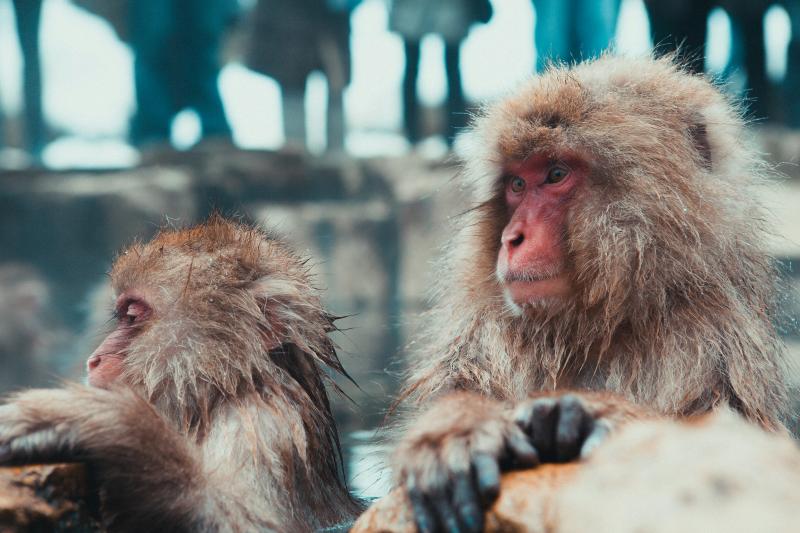
2) Yunokawa Onsen Hakodate: Seeing the Monkey Jumping into the Hot Spring
Yunokawa Onsen, located just five minutes by car from Hokkaido Hakodate Airport, is the closest hot spring resort to the airport in Japan, and it is very close to downtown Hakodate, so it is a good place to plan a one-day Japan Onsen trip. Not only is it conveniently located, but it is also one of the famous hot springs in the "Top 100 famous hot springs" and one of the three famous hot springs in Hokkaido, along with Noboribetsu Hot Spring and Jozankei Hot Spring. Hakodate Yunokawa Onsen is highly recommended for those who want to visit Hakodate and enjoy the Hokkaido hot spring at the same time.
Yunokawa Hot Spring has a history of over 350 years. It is a chlorinated spring, which is good for beauty, as well as cold limbs, nerve pain, and sore shoulders, so it's a good place to visit if you want to get rid of fatigue during your trip to Japan.
Yukura Shrine is a famous sightseeing spot around Yunokawa Onsen, as well as a great place to take photos. The historical shrine houses about 90 Japanese macaques in the tropical botanical garden "Saruyama Onsen", which is highly regarded as a place where you can see monkeys comfortably bathing in the hot springs. And you can see the monkeys jumping into this Hakodate Monkey Onsen, which is definitely an image you will want to take a picture of.
Now do you have a burning desire to visit Japan hot water springs? Find an Onsen spa of your choice for a comfortable soak and encounter one of these hot springs monkey Japan.
5. Recommended Japan Onsen Trip
As we have shared the best place for hot springs in Japan, if you are yearning to experience the thrilling Japanese Onsen, why not embark on our Japan hot spring trip? Contact us for a private tour with a private guide, private car transfer, and tailored itinerary.
5.1 Kyushu Onsen Culture Tour 7 Days
Quick Access>>>7 Days Fukuoka-Nagasaki-Itoshima-Kumamoto-Mt. Aso-Kurokawa-Yufuin-Beppu Tour
This 7-day hot spring tour in Kyushu features a diverse and immersive onsen (hot spring) experience, offering a blend of traditional and modern settings across various locations in Japan.
Summary of 7-Day Kyushu Hot Springs Tour
●Days 1-3: Fukuoka (Dazaifu Tenmangu Shrine, Kyushu National Museum, Ichiran no mori, Oyster hut, Wedded Rocks)
●Day 4: Nagasaki (Nagasaki Peace Park, Nagasaki Atomic Bomb Museum, Shinchi Chinatow, Inasayama Observation Deck)
●Days 5-6: Mt. Aso and Onsen (Yanagawa River Descending, Mount Aso, Yunotsubo Kaido, Hells Beppu)
●Day 7: Fukuoka Exit

Detailed Itinerary of the 7-Day Japan Hot Spring Trip
●Day 1: Arrival at Fukuoka
-Transfer to Hotel: Enjoy hassle-free transportation between the airport and your hotel in Fukuoka.
●Day 2: Fukuoka Highlights
-Dazaifu Tenmangu Shrine: Visit one of Japan's most significant Tenmangu Shrines, dedicated to Sugawara Michizane.
-Kyushu National Museum: Explore Japan's fourth national museum, known for its unique architecture and cultural exhibits.
-Nanzoin Temple: Witness the world's largest bronze statue of a reclining Buddha.
-Canal City Hakata: Shop and dine in this vibrant entertainment complex with over 250 shops, restaurants, and attractions.
●Day 3: Itoshima Exploration
-Ichiran-no-mori: Indulge in freshly made noodles at Japan's unique noodle workshop/store.
-Meoto Iwa: Experience the sacred rocks connected by a shimenawa rope representing husband and wife.
-Oyster Hut: Enjoy fresh seafood in a relaxed atmosphere at Silk Island.
-Shiraito Waterfall: Discover the picturesque Shiraito Falls on the Itoshima Peninsula.
-Fukuoka Tower: Ascend Japan's tallest seaside spire for breathtaking views of Fukuoka.
●Day 4: Nagasaki's Culture
-Nagasaki Peace Park: Pay tribute to the victims of the atomic bombing at this tranquil memorial.
-Nagasaki Atomic Bomb Museum: Gain insight into the impact of the atomic bomb on Nagasaki.
-Glover Garden: Explore historic Western-style residences in this open-air museum.
-Shinchi Chinatown: Delight in Nagasaki's oldest Chinatown and savor its renowned cuisine.
-Inasayama Observation Deck: Marvel at panoramic views of Nagasaki from atop Mount Inasa.
●Day 5: Kumamoto and Mount Aso Adventure
-Yanagawa River Descending: Cruise through Yanagawa's waterways, known as "the city of water."
-Kumamoto Castle: Explore one of Japan's most impressive castles with extensive grounds.
-Mount Aso: Experience the active volcano's vast caldera and breathtaking scenery.
-Kusasenri: Enjoy the iconic view of the emerald green grassland plateau atop Mount Aso.
●Day 6: Yufuin and Beppu Discovery
-Kokonoe Yume Otsurihashi Bridge: Walk Japan's longest pedestrian bridge for stunning views.
-Yunotsubo Kaido Street: Stroll through Yufuin's charming hot spring town with traditional shops.
-Lake Kinrin: Witness steam rising from the lake's surface and enjoy its tranquil surroundings.
-Hells Beppu: Explore Beppu's famous hot springs and natural wonders known as the "Seven Hells."
●Day 7: Departure
-Conclude your trip with convenient transportation from your hotel to Fukuoka airport.
While the itinerary primarily focuses on cultural, historical, and scenic attractions, it includes opportunities to experience onsen culture in Yufuin Onsen Oita and Beppu Hot Springs, Kurokawa Hot Spring, Fukuoka Onsen as well as potential relaxation options in other locations such as Nagasaki Hyogo.
▲Warm Tip: For more itinerary ideas on the Japan Onsen trip, or if you would like to spend 2 weeks in Japan to experience the Japanese hot springs, feel free to check out the 2-Week Onsen Tour Japan Itinerary Inspiration.
5.2 Trip to Japan Cost
How much would it cost to travel to Japan? How much is Onsen in Japan? The cost of visiting an onsen in Japan can vary depending on various factors such as location, facilities, and time of visit. Generally, the Japan onsen price for entry typically ranges from a few hundred yen to a few thousand yen per person. Some high-end resorts or Ryokans (traditional Japanese inns) may charge more for access to their exclusive Onsen facilities. Additionally, there might be extra charges for amenities such as towels or rental yukatas (Japanese robes), and the hot spring tax of around JPY 150 per guest per night is requested to be paid at the hotel front desk. And here is our cost of a trip to Japan for your reference.
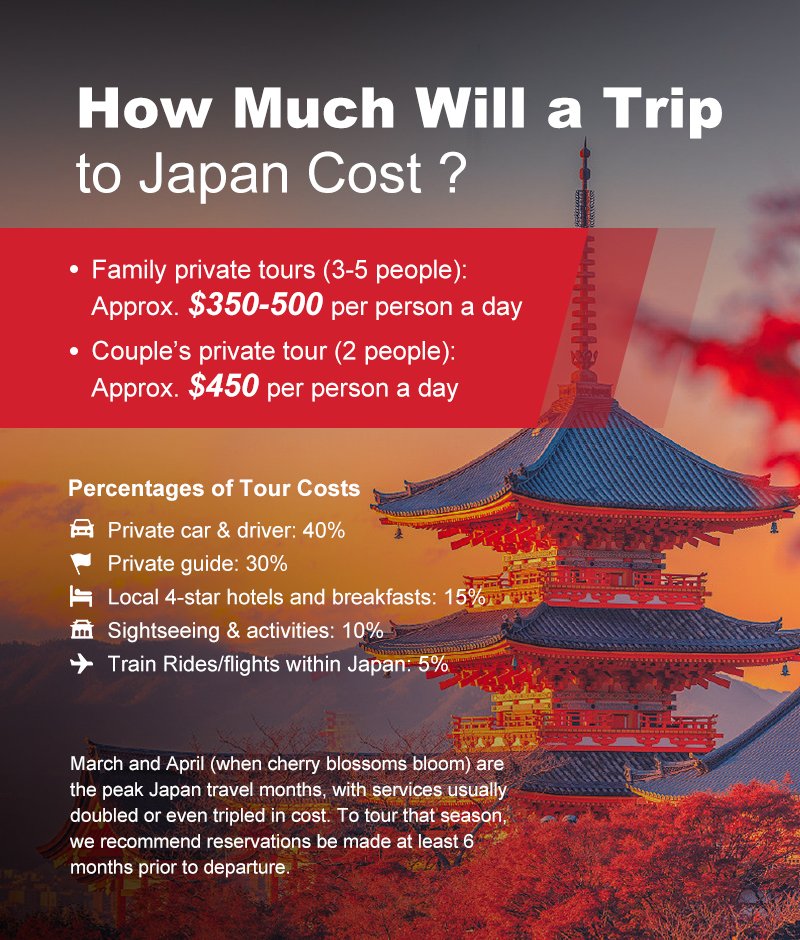
Japan Onsen bath during cherry blossom season is an amazing experience, but services usually are doubled or even tripled in cost. If you plan a Japan hot spring tour during the Sakura season, you are suggested to make the reservations at least 6 months before departure.
6. Best Ryokan in Japan: Japan Ryokan with Private Onsen
Almost all hotels in Japan offer hot spring baths, both Japanese and Western style. However, only hot spring hotels offer Japan natural hot springs. Ordinary hotels offer Japanese public bath house called “big Fero”, which can satisfy the hot feeling of "soaking in a hot spring", but they are not the same as "Japan natural Onsen" and do not contain the minerals found in Japan natural springs.
Since the development of hot spring hotels, there have been three room styles emerged: Ryokan, Western, and Modern. The Ryokan is the most traditional Japanese-style room, the Western style is a room with facilities similar to those of a business hotel, and the Modern style is mainly Japanese-style, but with beds instead of tatami mats. Visitors can choose their own according to their needs.
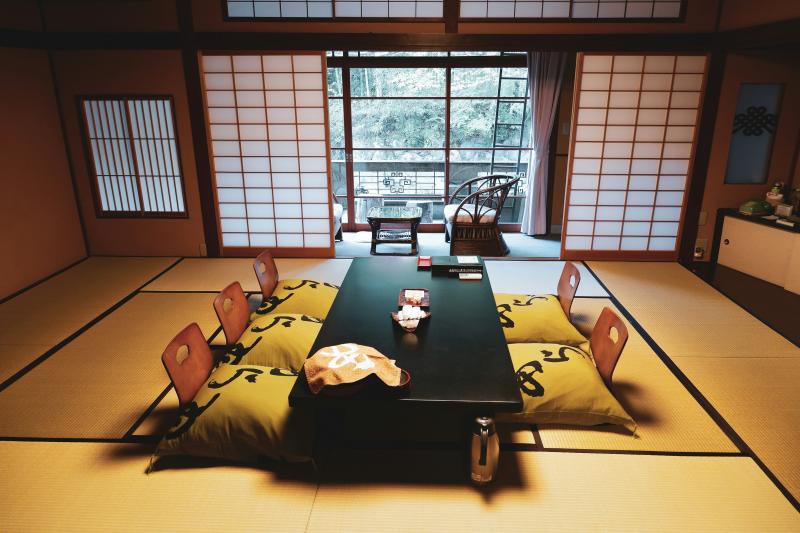
Here are the best Onsen Ryokan Japan, where you can experience the Hakone Ryokan Onsen, private Onsen Kyoto, Takayama Ryokan private Onsen and Kawaguchiko Onsen Ryokan, from which you will experience the ultimate integrated 360° Japanese service, comfortable hot springs, and a full sense of dining ritual.
| Destination | Ryokan Inn Name | Highlights |
| Best Hakone Ryokan | Sengokuhara Shinanoki Ichinoyu | 4-Star/Japanese-style Room/Private Onsen/Family Room/Breakfast And Dinner Included |
| Hotel Okada | 4-Star/Room with Private Onsen/Japanese-style Room/Breakfast And Dinner Included | |
| Ryokan Aura Tachibana | 4-Star/Large Room/ Japanese-style Room for 4 People/Breakfast and Dinner Included | |
| Hakone Kowakien TEN-YU | 5-Star/ Breakfast and Dinner Included/ More Rooms/ Beautiful Views | |
| Kyoto Onsen Ryokan | Kyoto Ryokan Kinoe | 4-Star/Gion/Japanese-Style Rooms/ Simplistic Japanese-Style Ryokan |
| Gion Ryokan Karaku | 4-Star/ Japanese-Style Room/Breakfast And Dinner Included | |
| Seikoro Ryokan | 5-Star/All Japanese-style Rooms/First-Class Service/Breakfast and Dinner Included/Family Stay Friendly | |
| Togetsutei Hotel | 4-Star/Japanese-style Room/Multiple Occupancy/ Breakfast and Dinner Included /Located in Arashiyama | |
| Kawaguchiko Hot Spring Ryokan | Shuhoukaku Kogetsu | 4-Star/Lake Kawaguchi/Mount Fuji |
| Oike Hotel | 4-Star/ Japanese-style Room/Breakfast Included/Some Rooms Can View Mount Fuji | |
| Fujisan Onsen Hotel Kaneyamaen | 5-Star/SPA Japanese-style Ryokan/Private Onsen in Some Rooms/Breakfast and Dinner Included | |
| Fuji Kawaguchiko Onsen Hotel Konansou | 5-Star/Japanese-style Room/Located by the Lake/Room with Private Onsen/ Breakfast and Dinner Included | |
| Best Ryokan Takayama | Ryokan Oyado Koto No Yume | 4-Star/ City Center/Breakfast Included/Japanese-style Room/Quadruple Occupancy Available |
| Honjin Hiranoya Bekkan Annex | 5-Star/ Hot Spring Hotel/Japanese-style Room/Breakfast and Dinner Included | |
| Hida Hanasatonoyu Takayama Ouan | 4-Star/ Japanese-style Room/Onsen Hotel/Breakfast Included |
7. Japanese Onsen Culture
Experiencing the Onsen is one of the top things to do in Japan. To fully enjoy the Japanese hot springs, it is better for you to learn about the things about Japanese Onsen, including the Onsen history and culture, the Onsen etiquette, and tips and reasons why Japanese people love Onsen bath.
7.1 What Makes Japan Onsen So Popular
Soaking in Japanese hot springs is a unique and tranquil experience that goes beyond just physical relaxation. The sensation is often described as incredibly soothing and rejuvenating. Here are the reasons why Onsen in Japan is so special and popular.
Natural Healing Properties: Many hot springs in Japan are located in geothermally active areas, resulting in mineral-rich hot spring waters. The minerals, such as sulfur, radium, and carbon dioxide, are believed to have various health benefits, including improved circulation, relief from muscle and joint pain, and skin rejuvenation.
Cultural Tradition: Onsen bathing is deeply ingrained in Japanese culture and has been a traditional practice for centuries. It is not just about physical health but is also seen as a way to relax, socialize, and connect with nature. Onsen experiences often involve a specific bathing etiquette, including thoroughly cleaning oneself before entering the communal baths.
Scenic Locations: Many onsens are situated in picturesque natural settings, surrounded by mountains, forests, or near the coastline. This creates a tranquil and serene atmosphere that enhances the overall experience of relaxation and rejuvenation.
Seasonal Appeal: Onsens can be enjoyed throughout the year, and each season brings its own charm and provides a unique experience. Soaking in a hot spring during the winter while surrounded by snow, or in the fall with colorful foliage, or under cherry blossom in spring adds an extra layer of beauty and enjoyment to the experience.
Variety of Bathing Facilities: There are various types of onsens in Japan, including outdoor baths (rotenburo), indoor baths, and mixed-gender or gender-separated facilities. Each type offers a unique experience, and visitors can choose based on their preferences.
Ryokan Experience: Many hot springs are connected to traditional Japanese inns called "ryokan." Staying at a ryokan provides a complete cultural immersion, combining onsen bathing with traditional Japanese hospitality, tatami rooms, and kaiseki cuisine, and yukata (traditional Japanese robes) to wear to the baths.
Overall, the feeling of soaking in Japan's Onsen combines physical relaxation, stress relief, cultural appreciation, and a connection with nature, providing a holistic and rejuvenating experience for both body and mind. And it is a calming experience when you soak in Japanese hot springs.
7.2 Why Japanese People Love About Onsen
How much do the Japanese love hot springs? Japanese people really love and enjoy soaking in the Onsen. In almost every Japanese television drama, there are such sequences: family vacations, girlfriends' talks, colleagues' gatherings, and even business talks are chosen at hot spring spas! They regard soaking in hot springs as a ritual. This love on hot spring is inseparable from the country's innate advantages. Japanese people are very bold when it comes to bathing in hot springs and like to soak naked. They believe that by taking off clothes, class relations are taken off. Without restraints, even people who do not know each other can communicate, and people who are familiar with each other become closer.
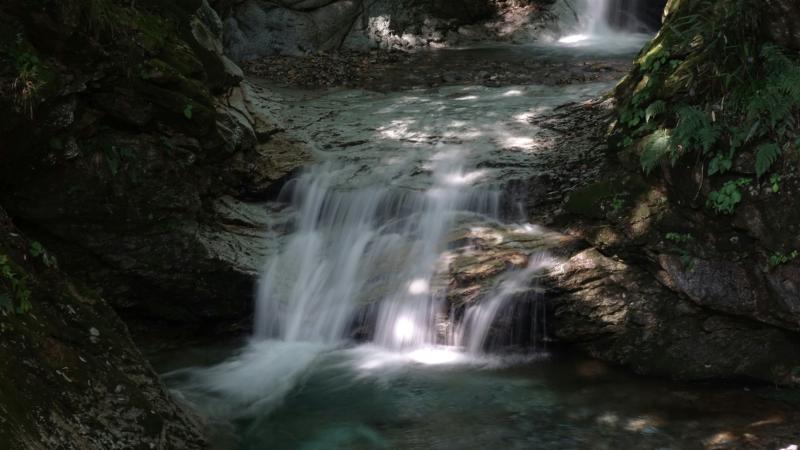
7.3 History and Culture of Bath House in Japan
"Sento" (or public baths) can be found all over Japan, and their history dates back to the Heian Period. The earliest Japanese public bath house in Edo (now Tokyo) is said to have been built in 1591 and grew in popularity. After World War II, when many households did not have bathing facilities, the bathhouse culture began to flourish and by 1968 there were over 18,000 bathhouses throughout Japan. Unlike Japan natural hot springs, traditional Japanese bath house does not usually use natural spring water. People go to bathhouses to communicate with local residents, or they go to bathhouses to enjoy bathing time because their homes have simple bathing facilities.
Although the number of bath house in Japans is not as high as it was in the heyday of the hot springs, in recent years, Japanese bathhouses have come up with a variety of creative ideas, such as paintings of Mt. Fuji or famous Japanese sightseeing spots on the walls, as well as electric baths, Kuroyuki-onsen hot spring baths, and herbal baths, to provide a more enjoyable bathing experience than ever before.
7.4 Japanese Onsen Etiquette and Tips
How to use Japanese hot springs? Japanese bathhouses use the kanji characters for "male" and "female" to differentiate between male and female areas, please follow the hot spring etiquette of not splashing or making a lot of noise when entering the bath.
1) When bathing in a hot spring in Japan, please follow the correct order of bathing. Wash your body in the public shower area before entering the hot spring pool, and do not scrub in the pool to avoid soiling the water. Before entering the bath, please use the restroom, which is usually located in or in front of the locker room.
2) Most bathhouses in Japan do not have toiletries, so please remember to bring towels, soap, etc.; even if you forget to bring them, you can buy them at a low price at the Japanese bathhouse.
3) Japanese hot springs are for the comprehensive purpose of bathing, recuperation, and relaxation, and their entertainment value is relatively weak. Most Japanese hot springs are nude baths, so you can't wear a bathing suit when soaking in the Japan hot spring.
4) Photographs are not allowed in the public baths of hot spring hotels, so please do not bring your camera into the onsen.
5) Avoid taking a Japanese onsen bath on an empty stomach or after a meal, as this can cause anemia or indigestion.
6) Please replenish water to prevent dehydration when you experience the Japan onsen hot springs. Do not soak for more than 10 minutes at a time, come out to take a shower and take a rest, drink some water, and then continue to soak; the elderly or people with heart disease should not soak in the Japan onsen spa for a long time.
7) In Japan, it is customary to drink a bottle of cold milk after bathing in the hot spring to refresh your body after relaxing. If you need a hot drink, you can boil water in your Japan Ryokan with a private onsen or buy it from a vending machine, convenience store, or hotel supermarket.
8. Frequently Asked Questions about Japan Hot Springs
Q1: Can You Go to Hot Springs in Japan with Tattoos
Are tattoos allowed in Japanese onsen? In Japan, there is a cultural association between tattoos and the yakuza (organized crime syndicates), which has led to some onsen (hot springs) establishments implementing rules against allowing people with tattoos to enter. However, attitudes towards tattoos are gradually evolving, and some onsen now accept guests with tattoos, particularly if they are small and can be covered with a bandage or adhesive patch. You can inquire directly with the onsen staff about their tattoo policy when making a reservation or upon arrival. If you have a small tattoo, you may still be able to visit certain onsen in Japan. And we have listed 3 Tattoo-Friendly Onsen in Japan that explicitly welcome guests with tattoos.
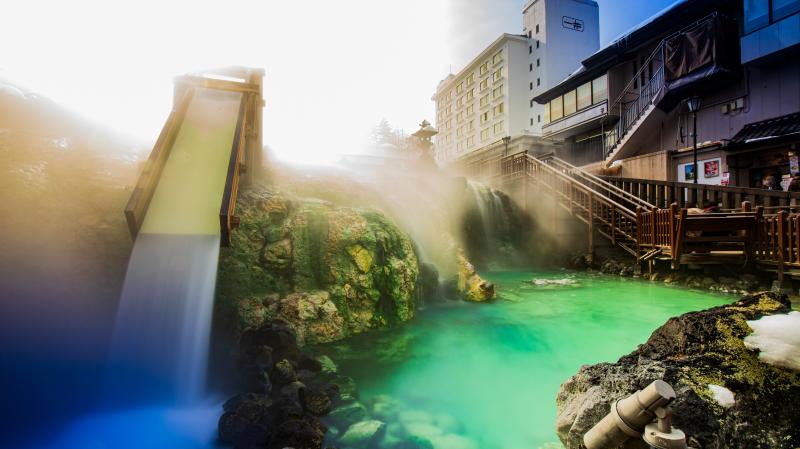
Q2: How Hot are Japanese Hot Springs?
The temperature of Japanese hot springs (onsens) can vary widely, and it depends on the specific onsen and its location. Japanese Onsen temperatures typically range from around 37°C (98.6°F) to 42°C (107.6°F). Some Onsens in Japan may have temperatures outside of this range, Some onsen resorts offer multiple baths with different temperatures, allowing visitors to choose the one that suits their preference. And it's essential for bathers to be aware of the water temperature of the Onsen Japan before entering.
Q3: Can Foreigners Visit Ginzan Onsen in Japan?
Yes, foreigners can visit Ginzan Onsen in Japan. Japan is generally welcoming to tourists from around the world to experience its unique hot springs, and Ginzan Onsen is a tourist destination that attracts visitors from various countries. Ginzan Onsen is a popular hot spring resort located in the mountains of Yamagata Prefecture. It's a picturesque village with historic buildings lining the riverbanks, creating a beautiful atmosphere, particularly in the winter when snowfall adds to its charm.
Q4: How Do Hot Springs Work in Japan?
In Japan, hot springs, or onsens, are an essential part of the culture, and using them involves a specific process. Upon arriving at an onsen facility or traditional inn (ryokan), visitors check in and find separate bathing areas for men and women. Before entering the communal hot spring, guests must thoroughly wash and rinse their bodies at the provided showers to maintain cleanliness. After showering, individuals can enter the onsen, choosing a pool with a comfortable temperature. It's customary to keep hair out of the water and to refrain from bringing large towels into the onsen. While in the onsen, visitors can relax in the soothing warm water, keeping noise to a minimum. After enjoying the onsen, a final rinse is required before returning to the changing area. Some onsen facilities provide small towels for modesty, and it's important to be aware of specific rules or instructions at each location. Overall, onsen bathing in Japan is a tranquil and rejuvenating experience deeply rooted in cultural traditions.
Q5: What Is the Difference between Ryokan and Onsen?
These two words are often conflated together because most people enjoy hot springs in a traditional Japanese inn setting. A Ryokan is a traditional Japanese inn where you can experience Japanese culture and hospitality, while an onsen is a hot spring where you can soak in the natural mineral water and relax.
Q6: Are Onsens Mixed Gender?
In Japan, most onsens have separate areas for men and women. This separation ensures privacy and comfort while bathing. However, there are some places where mixed-gender bathing is allowed, such as Takaragawa Onsen in Gunma, Nyuto Onsen in Akita, and Nishiyama Onsen in Fukushima.
Conclusion
In Japan, hot springs are suitable for all seasons of the year. Soaking in Japanese hot springs in spring, you can get rid of the winter coldness in the body; in summer get rid of the moisture in the body, while in autumn and winter build up your body's resistance and prepare for the coming dry weather. Tell us your travel date to plan a private guided Japan onsen trip now.


